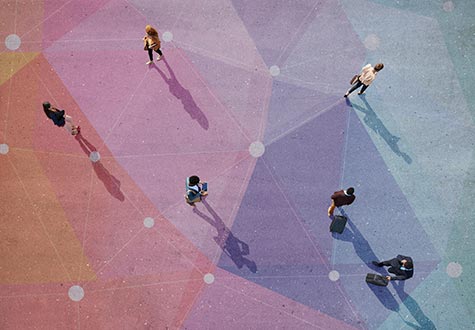
Shouting entire conversations with neighbors across the street. Switching sidewalks to avoid a fellow dog walker. Social distancing has affected the way we relate to those around us.
If we have to leave the house, we now know it’s everyone’s responsibility to stay at least 6 feet from each other. This will “flatten the curve” of the coronavirus spread. But what’s the science behind it?
As social distancing becomes the new normal in our daily lives, questions about how the virus spreads have naturally led to more questions, theories, and misinformation.
The Centers for Disease Control and Prevention (CDC) instructs that we “maintain at least 6 feet between all individuals, even those who are asymptomatic.” The virus spreads “between people who are in close contact with one another (within about 6 feet).”
Social Distancing Myths & Facts
Our infectious disease expert William Petri, MD, clarifies some of the confusion around how the coronavirus spreads. Surprisingly, of the statements we collected online and through hearsay, most were confirmed as facts, or leaning toward fact.
Indoor & Outdoor Conditions
Windy conditions can propel the coronavirus droplets beyond the 6 feet of social distancing. Humid conditions, on the other hand, can shorten their travel.
Fact. This is true, “especially for the microdroplets,” Petri says.
Virus molecules remain stable in cold weather or in colder, air-conditioned spaces.
Mostly fact. “To an extent,” Petri says, “the virus is more stable in cooler weather.”
Bright light helps to degrade the molecules.
Mostly fact. “UV light inactivates the molecules.” Petri elaborates: “It seems that UVC (light) is better at killing germs than UVA (light). Ultraviolet light works to kill germs by cross-linking damaging RNA or DNA, which has the genetic code for the bug.”
The smaller the space, the more concentrated the virus (e.g., elevators, cars, small rooms).
Fact. In a recent Daily Progress story, Petri says, “Talking with your neighbor six feet away from each other while outside is a lot safer than bringing the neighbor into your house and talking six feet away. In a short time, the room could, in theory, become toxic.”
Staying Power
The more time you spend within 6 feet of someone with the coronavirus, the greater the risk of infection.
Fact.
After a cough, sneeze or simple conversation, coronavirus molecules can stay in the air for three hours.
Fact. A recent CDC study shows that “speech and other vocal activities such as singing have been shown to generate air particles, with the rate of emission corresponding to voice loudness.” Petri elaborates, “Speaking is not as forceful of an action (as sneezing or coughing), but they found that the virus survived in the air for three hours.”
Person to Person
Forceful coughs and sneezes can propel the droplets beyond the 6 feet of social distancing, up to 27 feet.
Fact.
Bandanas worn as masks can stop the virus from spreading.
Fact. In the same Daily Progress article, Petri elaborates: “That it can stay in the air for so long makes wearing masks so important, even if it’s just a handkerchief. When you wear a mask you are protecting someone else and they are protecting you.”
Saliva excretion on sidewalks and jogging, cycling or hiking trails can potentially spread the virus through contact.
Fact. For a recent UVA Today article, Petri warns, “Avoid touching inanimate surfaces like doorknobs or railings when possible and – again – wash your hands often.”
As news of the virus started spreading in January of this year, he explained in UVA Today how the virus sticks to surfaces in “what we call fomites, which means that basically there’s a surface or something that is contaminated with the virus, and then you touch that surface and you can infect yourself.”
